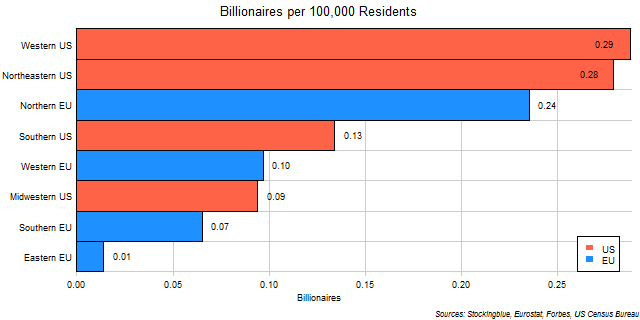
The chart above shows the number of billionaires per 100,000 people in each EU and US region. Half the regions in the EU and the US have more than one billionaire for every million residents.
Findings
- The difference between the region with the most billionaires per capita, the Western US, and the region with the least, the Eastern EU, is 0.27.
- The Western US has 20.52 times the billionaires per capita that the Eastern EU does.
- Bulgaria, Croatia, Estonia, Latvia, Lithuania, Luxembourg, Malta, and Slovenia do not have a single billionaire in the EU.
- Alabama, Alaska, Delaware, Louisiana, Mississippi, New Mexico, North Dakota, and Vermont do not have a single billionaire in the US.
Caveats
- Data is from 2018.
- Rates are rounded to the nearest hundredth.
- The Western US consists of California, Washington, Colorado, Arizona, Oregon, Utah, Nevada, New Mexico, Hawaii, Idaho, Alaska, Montana, and Wyoming.
- The Northeastern US consists of New York, Pennsylvania, New Jersey, Massachusetts, Maryland, Connecticut, New Hampshire, Delaware, Maine, Rhode Island, and Vermont.
- The Northern EU consists of Sweden, Denmark, and Finland.
- The Southern US consists of Texas, Florida, Georgia, North Carolina, Virginia, Tennessee, Louisiana, South Carolina, Alabama, Kentucky, Oklahoma, Arkansas, Mississippi, and West Virginia.
- The Western EU consists of Germany, United Kingdom, France, Netherlands, Belgium, Austria, Ireland, and Luxembourg.
- The Midwestern US consists of Illinois, Ohio, Michigan, Indiana, Minnesota, Wisconsin, Missouri, Iowa, Kansas, Nebraska, North Dakota, and South Dakota.
- The Southern EU consists of Italy, Spain, Portugal, Greece, Cyprus, and Malta.
- The Eastern EU consists of Poland, Czech Republic, Romania, Hungary, Slovakia, Bulgaria, Croatia, Slovenia, Lithuania, Latvia, and Estonia.
Details
Two US regions and one EU region have more than two billionaires for every million residents.
The US region with the lowest number of billionaires per capita rivals the second highest EU region in the metric.
Sources
Eurostat. 2017. "Population on 1 January by Age Groups and Sex - Functional Urban Areas." Accessed December 11, 2017. http://appsso.eurostat.ec.europa.eu/nui/show.do?dataset=urb_lpop1&lang=en.
Forbes. 2018. "The World's Billionaires List." Accessed October 2, 2018. https://www.forbes.com/billionaires/list/21/#version:static.
United States Census Bureau. "Annual Estimates of the Resident Population: April 1, 2010 to July 1, 2016." Accessed December 12, 2017. http://factfinder2.census.gov.